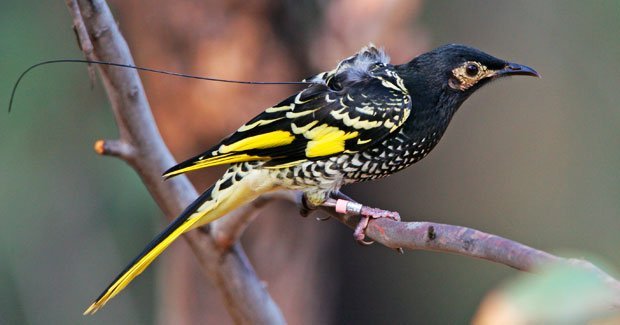Critically endangered birds fly free

FORTY-FOUR CAPTIVE-BRED regent honeyeaters were released into the wild in Victoria last week. This follows a successful 2008 trial release which granted 27 of these critically endangered birds their freedom.
Sarah Kelly, biodiversity officer from the Department of Sustainability and Environment (DSE), Victoria, says the positive results of the first trial exceeded expectations: “The hope is that the captive-bred birds will mate with the wild birds, increasing the population base of the species.”
Currently, there are thought to be just 800 to 1500 wild honeyeaters left across Australia. In Victoria, numbers hover around 100, with only 11 sightings recorded this year.
Advantages of captivity
Dean Ingwersen, regent honeyeater
recovery
coordinator at Birds Australia, says reasons for the species’ decline include “pressure
from the
continuing effect of historic land clearing, food scarcity due to
drought, and competition from more aggressive species which out-compete
them in their favoured woodland habitat.”
Captive-bred at Adelaide Zoo and Sydney’s Taronga Zoo, the latest batch of birds were released into the Chiltern-Mt Pilot National Park, Victoria last week. This subsequent release is the largest group that the national park has hosted since an influx of about 50 wild honeyeaters in 1998.
The birds will be tracked over a 12-week period with the aid of coloured leg bands and radio transmitters.
Breeding hope for future
Though the captive-bred birds were trained to forage and recognise their wild cousins’ calls, regent honeyeaters have a natural ability to adapt. Senior biodiversity officer Glen Johnson from the DSE, Victoria, says “the honeyeaters are generally very well adapted to the environment once they are released, and well-attuned to reacting to alarm calls.”
These gregarious birds are also more likely to survive and breed
successfully in large numbers. Glen says major injection of numbers
will increase the viability of the species and the opportunities of
seeing them in the future.
Dean agrees that “if all goes according to plan, a bigger number of birds may be released in potential future releases because the greater the number, the higher the chances of them incorporating into the wild and breeding.”
READ MORE
Regent honeyeaters: Saviour of a species

